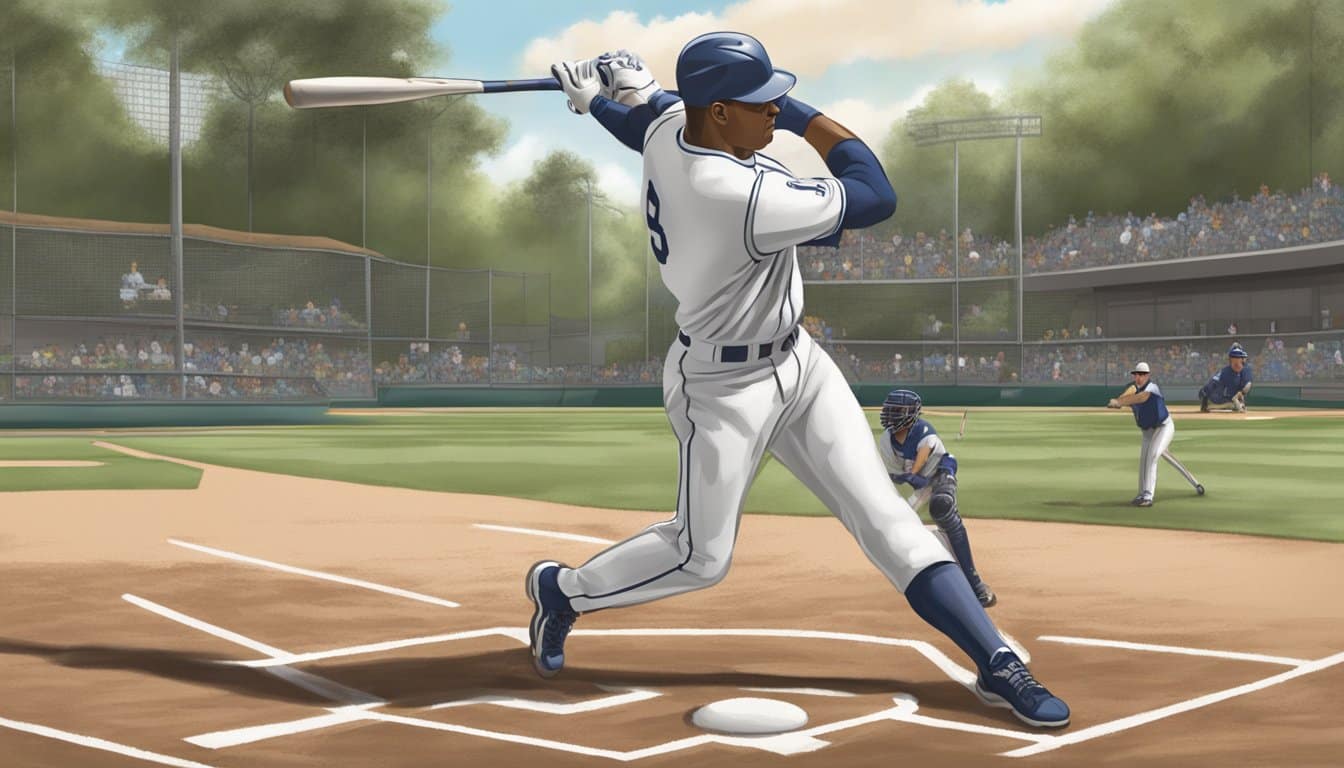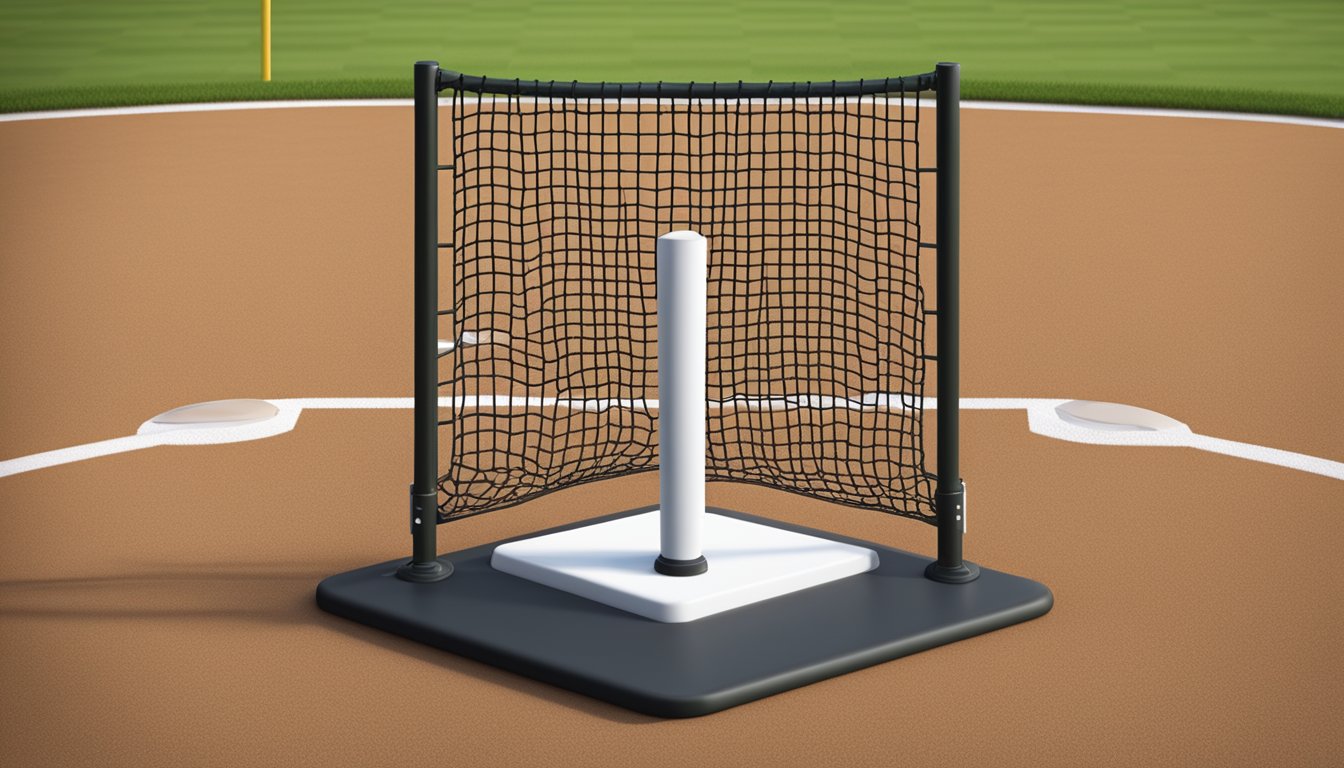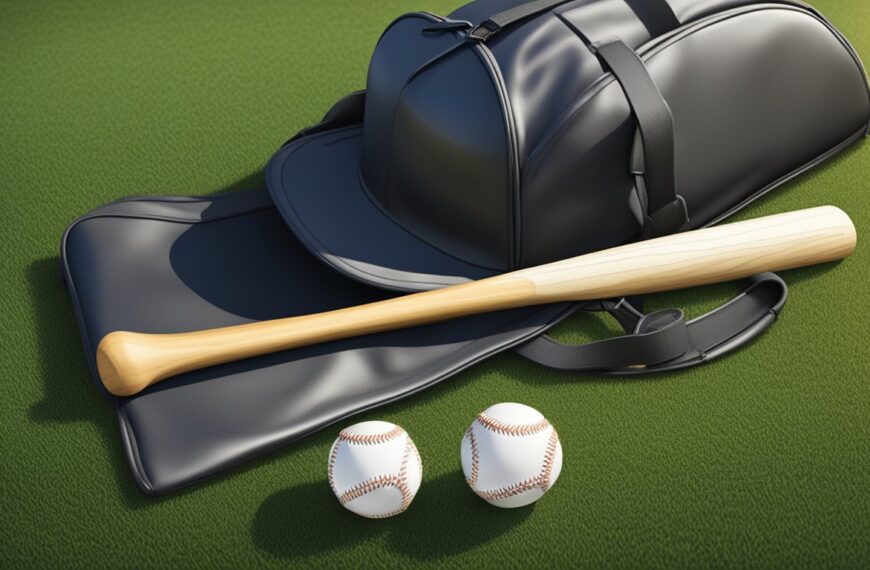Improving one’s swing in baseball is a critical aspect of enhancing overall batting performance. A batting tee can be an indispensable tool in this endeavor, offering a stationary position from which to practice swings with consistency. By using a batting tee, players of all levels have the opportunity to focus on their swing mechanics without the variable of pitch speed and location. This type of practice allows for repetition and muscle memory development that is crucial for swing improvement.
The effectiveness of a batting tee in swing training lies in its simplicity and the direct feedback it provides. Hitters can isolate and work on specific components of their swing in a controlled environment. This focused approach enables the correction of flaws, strengthens proper techniques, and builds confidence at the plate. By incorporating routine tee work into practice sessions, hitters can experience significant improvements in their batting performance.
Key Takeaways
- A batting tee is a vital tool for enhancing swing mechanics and consistency.
- Focused practice using a tee helps identify and correct swing flaws.
- Routine tee work is integral to developing confidence and improving batting performance.
Understanding the Batting Tee
https://www.youtube.com/watch?v=hXWwZkQ7rII&embed=true
A batting tee is an essential tool for baseball and softball players looking to hone their swings. It allows for consistent practice and helps in developing muscle memory for accurate hits.
History and Evolution of Batting Tees
The batting tee, traditionally a simple design consisting of a rubber top and metal base, has made significant strides since its inception. Joe Tanner revolutionized the batting tee with the introduction of the Tanner Tee. It features a more sophisticated design, accommodating the nuanced needs of hitters by combining durability with portability.
Types of Batting Tees
Batting tees come in various forms, from basic models to advanced versions like the Tanner Heavy and Tanner Pro.
-
Standard Tee
- Simple design
- Adjustable height
-
Tanner Tee
- Lightweight yet durable
- Patented friction technology for easy height adjustment
Portable vs. Stationary
- Portable tees are designed for easy transportation, often made from lightweight alloys.
- Stationary tees tend to be heavier, often weighted at the base for stability.
Material Construction
- Rubber tops reduce bat damage upon impact.
- Metal alloy bases ensure longevity and resistance to wear and tear.
Selecting the Right Batting Tee
Choosing the right batting tee involves considering several factors, such as durability, portability, and the player’s skill level.
-
Durability
- Metal bases over plastic for longevity
- High-quality rubber components for frequent use
-
Portability
- Look for lightweight designs like the Tanner Tees for easy transport
-
Skill Level
- New players may benefit from a basic model
- Experienced players might prefer the Tanner Pro, which offers sturdier construction and a finer touch for swing training
In selecting a tee, players should consider intended use—whether for casual practice or rigorous training.
Fundamentals of Batting
https://www.youtube.com/watch?v=BxvqvGQXSws&embed=true
In baseball, mastering the fundamentals of batting is essential for players to consistently make powerful and accurate hits. Proper hitting mechanics, stance, grip, and swing all contribute to improved bat speed and muscle memory, ensuring hitters can effectively find contact points on the barrel of the bat.
Hitting Mechanics
Hitting mechanics refer to the sequence of movements that players execute when preparing and actually hitting a baseball. Efficient mechanics are crucial for generating power, speed, and control in a swing. A player’s ability to coordinate their entire body — from legs, hips, torso, to shoulders, and down to the wrists — determines the quality of the swing. Consistent practice using a batting tee can help in engraining these movements into muscle memory, resulting in a more automatic and effective swing over time.
Stance and Grip
Stance and Grip are foundational to a hitter’s success. The stance serves as the starting position from where a hitter initiates their swing. Players should maintain a balanced and comfortable posture with feet shoulder-width apart, knees slightly bent, and weight evenly distributed or slightly back.
The Grip on the baseball bat influences control and power. Hitters should grip the bat with their hands aligned, knuckles of both hands forming a straight line. The grip should be firm but relaxed, avoiding tension that can slow down bat speed.
The Swing
The Swing is a complex motion that incorporates various elements of the hitter’s body to strike the ball effectively. The sequence generally starts with the load or coil, progresses to a stride towards the pitcher, and culminates with the rotation of the hips followed by the upper body. The goal is to swing the bat in a smooth, level path, allowing the barrel of the bat to make solid contact with the ball at one of the key contact points. Accelerating the bat through the hitting zone is essential for driving the ball with force. Hitters often use tees to isolate and refine each part of their swing, from initial movements to the follow-through, which should end with the hitter’s weight transferred to the front leg and their view following the direction of the hit ball.
Tee Work Essentials
https://www.youtube.com/watch?v=gQ_LRlAD__c&embed=true
Effective tee work is a cornerstone of productive batting practice. It refines a player’s swing mechanics, improves hand-eye coordination, and solidifies strike zone awareness.
Proper Tee Placement
Placement of the batting tee is critical for effective swing practice. The tee should be positioned in alignment with the player’s leading hip to simulate an optimal contact point. It’s important to start with the tee placed directly over the plate to encourage contact at the standard point of hitting.
Adjusting Height and Angle
Height and angle adjustments are necessary to mirror the variety of pitches a player will face. For a pitch down the middle, the height of the tee should be set at the midpoint of the strike zone, letting the batter work on a level swing path. Tweaking the angle helps simulate inside and outside pitches, enabling the batter to practice making solid contact with different parts of the strike zone.
Strike Zone Awareness
A batter’s strike zone awareness sharpens by practicing on a batting tee. The player should practice hitting the ball at different heights and depths within the strike zone to understand where their power zone is and where they can make the best contact. This involves systematically moving the tee to cover the entire strike zone, reinforcing the batter’s ability to make adjustments during live pitching.
Drills and Techniques
https://www.youtube.com/watch?v=VBGjLcNTbLw&embed=true
Proper technique is essential for making the most of batting tee practice. The following drills focus on balance, weight transfer, hand-eye coordination, and power hitting—key elements for developing a consistent and powerful swing.
Balance and Weight Transfer Drills
The Step-Behind Drill: The batter begins by stepping behind the tee with the back foot, then stepping forward into their normal stance while swinging. This drill reinforces proper balance and encourages smooth weight transfer from back to front during the swing.
The Stride Drill: Have the batter take a small stride towards the tee before making contact. This drill helps in maintaining balance throughout the swing and builds muscle memory for effective weight transfer.
Hand-Eye Coordination Drills
The Varied Height Drill: Adjust the tee to different heights to practice swinging at various pitch locations. Batters must keep their eyes focused on the point of contact, which enhances hand-eye coordination.
The Inside/Outside Pitch Drill: Positioning the tee inside and outside the strike zone simulates different pitch locations. This trains the batter to adjust their swing path for making solid contact on various pitch types.
Power Hitting Drills
The High Tee Drill: Set the tee at the top of the strike zone or slightly above it. Batters work on hitting high pitches with an upward swing path, increasing power and bat speed.
The Walk-Up Drill: The batter starts several steps behind the tee and walks into their stance, swinging as they approach. This drill builds momentum, which translates into greater power upon contact.
Advanced Training Strategies
https://www.youtube.com/watch?v=XwHLwDVRjjU&embed=true
Incorporating advanced training strategies while using a batting tee can greatly enhance a batter’s ability to respond to live pitching conditions. These tactics allow for simulating pitch locations and speeds, refining swings for hitting to the opposite field, and practicing with various bat types to develop a well-rounded approach at the plate.
Working with Pitch Simulation
By adjusting the tee height and position, batters can replicate various pitch locations, such as inside and outside pitches. To mirror a live pitcher’s delivery, players should shift the tee to correspond with typical pitch paths. They can use the following table as a reference:
| Tee Position | Simulated Pitch |
|---|---|
| Front of the plate | Fastball down the middle |
| Back of the plate | Changeup or curveball |
| Close to the batter | Inside pitch |
| Away from the batter | Outside pitch |
Practicing with these configurations hones the batter’s ability to make solid contact across all pitch types.
Hitting to the Opposite Field
Batters working on hitting to the opposite field should focus on pitch locational awareness and timing. For right-handed hitters, hitting to the opposite field means driving outside pitches to the right side; conversely, left-handed hitters aim left. The key is to let the ball travel deeper into the hitting zone before making contact, thus allowing it to naturally travel to the opposite field. Consistent practice on the tee with outward pitch locations can solidify this skill.
Utilizing Different Bat Types
Using various types of bats, particularly the transition from metal to wood bats, can significantly benefit a batter’s training regimen. Wood bats, which often have a smaller sweet spot and require more precise contact, can help refine a batter’s swing and improve their hand-eye coordination. Practicing with heavier bats can also enhance strength, while lighter bats can improve swing speed. A list of suggested practice routines includes:
- Metal Bat: Regular practice for familiarity and building confidence
- Wood Bat: To improve precision and adjust to weight differences
- Weighted Bat: For strengthening swing muscles and increasing bat speed
Engaging regularly with different bat types can lead to improvements in overall hitting performance during live game situations.
Preventing and Correcting Common Mistakes
https://www.youtube.com/watch?v=PIuzV5FtzS4&embed=true
Effective training with a batting tee involves recognizing and addressing common pitfalls that can impede a hitter’s progress. Focusing on technique, hand-eye coordination, and proper contact points can substantially enhance swing mechanics.
Avoiding Bad Habits
Bad habits at the plate can stem from improper body positioning and movement. For instance, dropping the shoulder may lead to an uppercut swing, causing inconsistency. To prevent this:
- Stance: Ensure the feet are shoulder-width apart, weight evenly distributed.
- Balance: Maintain balance throughout the swing to prevent overreaching for the ball.
A hitter should concentrate on keeping the head down and eyes on the imaginary pitch’s path to improve hand-eye coordination.
Improving Consistency
Consistency in the swing is critical for solid and regular contact with the ball. To refine consistency:
- Repetition: Practice the same swing motion to develop muscle memory.
- Drills: Utilize varied tee positions to simulate different pitches.
Repetition of proper form leads to more predictable outcomes and a more compact, efficient swing. A general rule is to hit the inside pitch slightly in front of the plate, while contact with an outside pitch should occur closer to the body.
Adjusting Swing for Different Pitches
Recognizing and adapting to different types of pitches is a skill a hitter must perfect. When confronting an inside pitch versus an outside pitch, adjustments are made as follows:
| Pitch Type | Tee Position | Point of Contact | Swing Adjustment |
|---|---|---|---|
| Inside Pitch | Slightly in front | Just before center | Compact, quick swing with hands close to the body |
| Outside Pitch | Deeper in the stance | Closer to the body | Extended arms, aim to drive the ball the other way |
By manipulating the tee settings and practicing swings tailored to these pitches, a hitter can achieve better plate coverage and control where the ball is hit.
Integrating Tee Work into Practice Routines
https://www.youtube.com/watch?v=wJESBI0OOhc&embed=true
Integrating tee work into a batter’s practice routine is crucial for developing a consistently powerful swing. It offers a controlled environment for perfecting hitting mechanics and building muscle memory.
Developing a Personalized Training Plan
A personalized training plan is essential to effectively integrate tee work into a practice routine. The individual plan should outline specific batting goals, the frequency of tee work sessions, and the range of drills suited to the batter’s level. For instance, a plan might include:
- Daily Tee Work Sessions: They may start with a set number of swings aimed at reinforcing contact points and progress to situational hitting drills.
- Progress Tracking: Regular evaluations to adjust the training plan and measure improvements in swing mechanics.
Incorporating Live Pitching Sessions
While tee work is an excellent training aid, a batter also needs exposure to live pitching to anticipate the variability of in-game scenarios. Coaches should blend tee work with coach pitch sessions, simulating real pitches. This combination can be structured as a routine:
- Start with 15 minutes of tee work focusing on swing fundamentals.
- Proceed with 10 minutes of soft toss to transition from static to dynamic.
- Conclude with 20 minutes of live pitching drills, integrating the adjustments made during tee work.
Using Tee Work as a Warm-Up
Tee work serves as an effective warm-up exercise before batting practice or games. This routine primes the muscles and reinforces proper hitting mechanics. A warm-up might include:
- A series of swings focusing on different parts of the hitting zone.
- A light tee work progression, increasing in intensity, to prepare the batter for live pitching.
In summary, a carefully designed practice routine that incorporates tee work alongside live pitching sessions can substantially enhance a player’s hitting skills. Coaches should carefully monitor player progression, ensuring that tee work remains a consistent and focused element of batting practice.
Selecting and Maintaining Equipment
Selecting the right equipment and maintaining it properly is essential for getting the most out of a batting practice session. The bat and the batting tee are primary components that require attention to detail for optimum swing improvement.
Choosing Your Bat
When selecting a bat, players must consider the material and weight. Wood bats are traditional and offer a classic feel, but they can vary in weight distribution and durability. Alloy or metal bats, on the other hand, are often lighter and more durable. Below is a quick reference table for bat selection:
| Bat Type | Material | Weight | Durability | Use Case |
|---|---|---|---|---|
| Wood | Natural | Varied | Medium | Training, Classic game scenarios |
| Alloy/Metal | Synthetic | Lighter | High | Practice, Younger players |
Caring for Your Batting Tee
Proper maintenance of a batting tee extends its lifespan and ensures consistency in practice. The Tanner Heavy and Tanner Pro are both excellent choices, known for their durability and stability. Users should regularly check for:
- Stability: Ensure the tee is weighted properly to prevent tipping.
- Wear and tear: Inspect for cracks or damage, particularly in the post and base.
- Adjustability: Verify moving parts function correctly for height adjustment.
Durable tees, like the Tanner models, are designed to withstand rigorous training, but they still benefit from routine checks and storage away from extreme temperatures and moisture.
Gaining Competitive Edge
https://www.youtube.com/watch?v=fs3KL2bacc0&embed=true
To excel in competitive baseball, understanding and implementing advanced batting techniques and strategies is crucial. Players who optimize their use of the batting tee can see significant improvements in their swing, giving them an edge over their competition.
Analyzing Professional Techniques
Professionals like Doug Bernier have honed their swings through meticulous practice. By studying their approach – stance, grip, and swing mechanics – players can integrate successful elements into their own routines. Specific techniques such as the hip hinge and stride can be repeatedly practiced using a batting tee. Video analysis is an effective tool for comparing one’s own technique against that of professional hitters.
Learning from Coaches and Mentors
Engaging with a coach or mentor provides personalized feedback that can dramatically improve a player’s approach at the plate. Coaches offer insights on hitting philosophies and tactical adjustments, while mentors can share experiences regarding mental preparation for competing. Through batting practice, primarily within a batting cage, the player can focus on implementing the nuanced advice received during coaching sessions.
- Listen actively during coaching for unique pointers.
- Apply coaching advice during tee practice to solidify adjustments.
Adjusting to Competitive Scenarios
A batting tee can help simulate real-game scenarios and pressure. Players should practice hitting various pitch locations and speeds to mimic in-game situations. For instance, adjusting the tee to a lower position can replicate hitting a low pitch, while higher placement can train the batter to handle high pitches.
- Practice hitting outside pitches by positioning the tee accordingly.
- Train for velocity changes by altering swing timing during tee practices.
Utilization of the batting tee with these focused strategies prepares a player to face the multitude of demands that come with competing at higher levels.
Frequently Asked Questions
https://www.youtube.com/watch?v=Ok3nw6pMUmI&embed=true
Effective use of a batting tee can drastically improve a player’s swing by focusing on mechanics, precision, and power. This section addresses common inquiries to optimize batting tee practices.
What drills can I perform with a batting tee to enhance hip rotation in my swing?
A player might perform the ‘Stride and Rotate’ drill which emphasizes stepping into the swing and then pausing before rotating the hips and completing the swing. This isolates hip movement and strengthens muscle memory for better in-game hip rotation.
Which are the top-rated batting tees recommended by professional coaches for swing training?
Professional coaches often recommend sturdy, adjustable tees such as the Tanner Tee or Backspin Tee. These tees are known for their durability and the flexibility they offer in adjusting for different types of pitches.
How can I position the batting tee correctly to improve contact with the ball?
For ideal ball contact, position the tee so the ball aligns with the front armpit when the batter is in their stance. This position encourages hitting the ball with the sweet spot of the bat, optimizing contact quality.
What are some effective hitting stick drills to improve my batting precision?
Utilizing a hitting stick, players can practice the ‘Soft Toss Drill’ by having a partner gently toss balls towards them, ensuring they focus on striking the ball accurately and consistently. This drill enhances eye-hand coordination.
What techniques can I use to maximize power in my baseball swing when practicing with a tee?
To maximize power, players should concentrate on driving through the ball with their legs and core, ensuring a full extension of the arms after contact. Practicing with a slightly heavier bat on the tee can also build the muscles used during the swing.
Do professional baseball players incorporate batting tees in their training regimen, and how?
Yes, professional players regularly use batting tees to refine their swing mechanics. They often focus on swing path and point of contact by placing the tee at various heights and locations, simulating different pitch locations.









